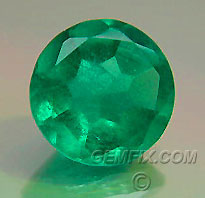EMERALD is the birthstone for the month of May. The word “emerald” comes from Latin smaragdus, via Greek smaragdos, its original source being a Semitic word izmargad or the Sanskrit word, marakata, meaning “emerald” or “green”. The ancient Egyptians mined emeralds near the Red Sea nearly 4,000 years ago, and Cleopatra prized emeralds above all other gems. 16th Century Spanish explorers found large emeralds in the possession of the Incas and Aztecs of South America, who regarded the emerald as a holy gemstone.
Unlike many other gemstones, emeralds always contain some inclusions with more, less, or no effect on durability and wear. Of particular concern would be any presence of cracks, which can sometimes be dangerous during the process of setting. Therefore, in addition to using the GIA clarity system throughout our website, we are adding specific remarks in the description of a particular stone if it contains cracks that could be of special concern during the setting process. However, even if such remarks are not posted, everyone handling emeralds should be very careful and follow the trade guidelines on handling these gemstones. Note to consumer: Emeralds should never be placed in an ultrasonic cleaner.
Please note: Emeralds are one of the most difficult gemstones to capture properly in digital images. Particularly many of the Columbian emeralds with their intense “stop light” green color with a bluish tint, are impossible to properly show in these images. Each emerald shown below looks much, much better in person than in these pictures. Also, keep in mind that the images below are several times enlarged which can be comparable to looking at the stones through magnification. Many of the inclusions visible in the images are not nearly as noticeable with the naked eye.
